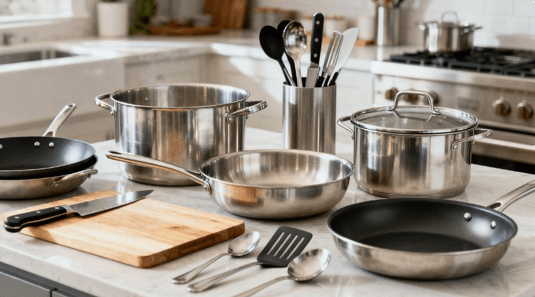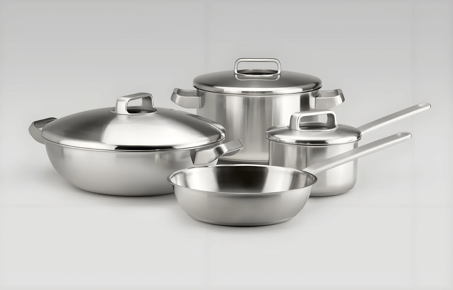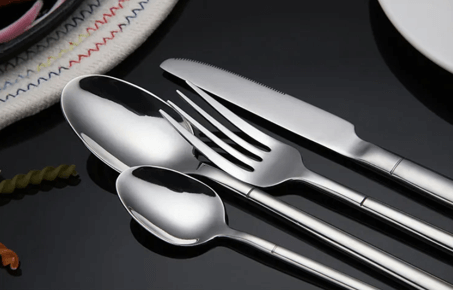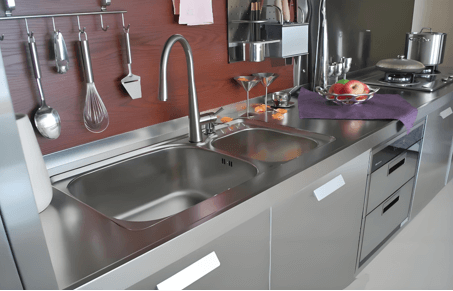QD is a manufacturer of stainless steel kitchenware components. Our stainless steel kitchenware sells well in multiple countries.

Core Advantages of QD Stainless Steel Kitchenware
Exceptional Material Safety
We strictly use austenitic stainless steels like 304 and 316L. These grades comply with China’s GB 4806.9-2016 standard for food contact materials. This ensures fundamental food safety.
Unlike cookware with chemical coatings, QD’s stainless steel products have a seamless cooking surface. There is no risk of coating peeling. This eliminates any risk of chemical ingestion.
We provide complete material traceability and certification documents. This guarantees our products are trustworthy.
Excellent Durability
QD stainless steel kitchenware offers high durability. This significantly lowers long-term costs.
- It effectively resists corrosion from acids, alkalis, and salts in food. It does not rust easily and maintains its like-new appearance for a long time.
- It has excellent strength at high temperatures. It resists deforming or softening on open flames or electric stoves.
- The surface is very hard. It withstands daily scraping from utensils and frequent cleaning without easily scratching.
Excellent Practical Features
The kitchenware surface is smooth, dense, and non-porous. Grease and food residues cannot easily penetrate or stick. Simple cleaning with water and a soft cloth is usually sufficient. Maintenance is easy.
QD uses advanced technology to develop clad bottom structures for cookware. We use a “steel-aluminum-steel” triple-layer composite pressing process. This utilizes aluminum’s excellent thermal conductivity to compensate for pure stainless steel’s slower heat transfer. It enables faster and more even heating across the pot body. It effectively prevents localized burning.
The design combines aesthetics with hygiene. The metallic luster of stainless steel gives the kitchenware a modern, professional look. The clean surface inhibits bacterial growth.
Applications of Stainless Steel Kitchenware
Our product line covers all kitchen needs from cooking to food preparation, including utensils and equipment.
Cookware Series

Saucepans, frying pans, and steamers: They use thick clad bottoms for even heat distribution.
Baking molds: Such as baking sheets and cake pans.
Cutlery Series

Knives, forks, spoons, chopsticks: Made from 420 (martensitic) stainless steel.
Plates and bowls: Stamped from a single piece. They have no seams or hard-to-clean corners.
Kitchen Equipment & Accessories

Countertops and cabinet bodies
Sinks and drying racks
Commercial kitchenware: Such as seasoning containers, stock pots, and filter nets.
Production Process and Quality Assurance
Strict Material Selection
All stainless steel sheets and billets must provide food-grade material certificates.
We scientifically select steel with different thicknesses and grades based on the usage intensity of each product.
Precision Manufacturing Processes
1. Precision Stamping and Deep Drawing:
We use high-tonnage hydraulic presses and precision molds. These perform single or multiple stamping and deep drawing operations on metal sheets. This forms pot bodies and bowl bodies. This ensures the product is seamless, structurally strong, and has smooth contours.
2. Surface Treatment Technology:
- Mirror Polishing: Enhances surface smoothness. It improves appearance and makes cleaning very easy.
- Brushed Finishing: Creates fine satin-textured lines. It offers a premium feel and effectively hides fine scratches.
3. Edge Treatment Process:
All product edges undergo hemming or polishing. This makes them smooth, rounded, and free of sharp burrs.
Full-Process Quality Inspection
We have established a comprehensive quality control system. This includes inspecting incoming raw materials, performing random dimensional checks during production, and conducting final product tests. These final tests include pressure tests, salt spray tests (for corrosion resistance), and 100% visual appearance inspection.
Contact Us
We are QD Foundry. In stainless steel kitchenware, we provide more than just products. We deliver complete solutions focused on safety, efficiency, and durability. Whether you are a food service business seeking reliable bulk purchases, or a household that values quality of life, QD is your trusted partner. If you need stainless steel kitchenware, please contact QD.

FAQ
1. Why do some stainless steel pans cause food to stick?
Stainless steel pans are not completely non-stick. Their anti-stick effect relies on adequate preheating and proper oil temperature. QD’s clad bottom cookware distributes heat more evenly. This helps reduce localized overheating and minimizes sticking.
2. Can stainless steel kitchenware be used on induction cooktops?
Yes, but the pan base must be flat and magnetic. Pure austenitic 304/316L stainless steel is non-magnetic or weakly magnetic, so it does not work on induction cooktops. To solve this, QD’s induction-compatible pans either embed a ferromagnetic stainless steel layer in the clad base or have a magnetic disk welded to the bottom. This ensures compatibility with induction cooking.
3. Does QD accept custom orders for kitchenware with company logos or special specifications?
Yes. Customization is one of our core strengths. We can adapt production based on your requirements for specifications, thickness, surface finish, and logo etching.
4. Why do water spots appear on stainless steel utensils after washing? How to remove them?
Water spots are mineral deposits (calcium, magnesium) from hard water. They are harmless and do not affect functionality. Wipe gently with a soft cloth dipped in white vinegar or lemon juice, then rinse with water and dry thoroughly. Regular drying after washing helps prevent their formation.
5. What are the main differences in material and manufacturing between commercial and household stainless steel kitchenware?
The key differences lie in material thickness and durability requirements. Commercial kitchenware undergoes extremely frequent use, so it typically uses thicker gauge steel. Its welds and structural reinforcements are also stronger. QD offers specially designed product lines for commercial clients that prioritize maximum durability and efficiency.
